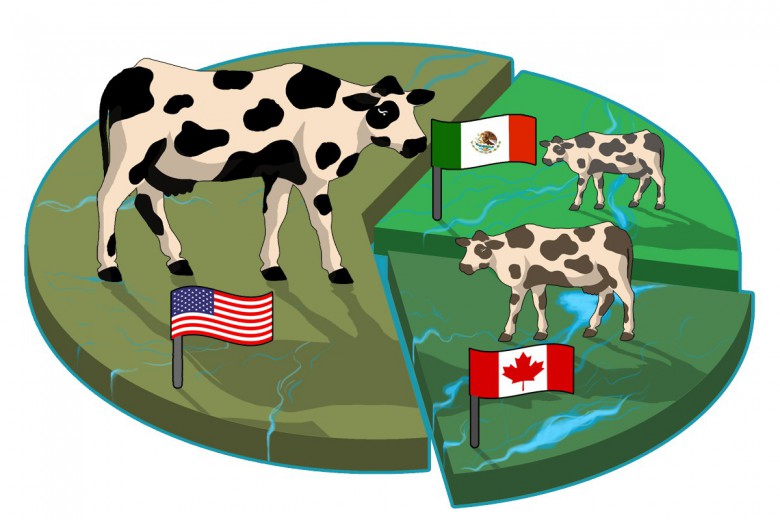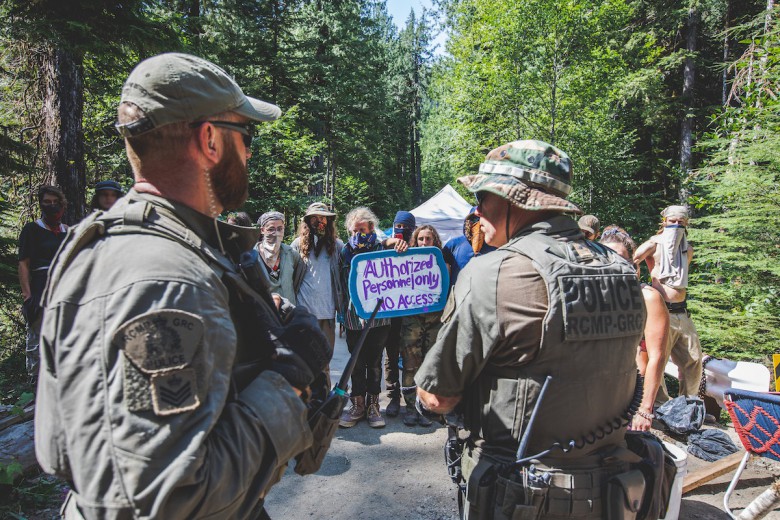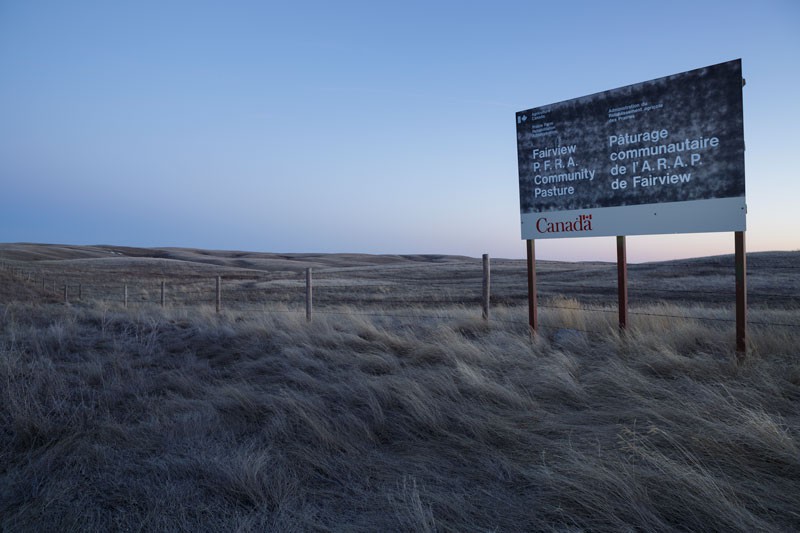
It was the end of January. On a snow-covered hilltop overlooking miles of remnant prairie, as I churned inside with all the things I might say for that prairie, the raven came to see me. I laughed and let it all be. Two days later, with the courage and contrary confidence of that big black bird, I took my place at the microphone for my first radio interview, speaking for the new group Public Pastures – Public Interest about the uncertain future of the grasslands known as the PFRA community pastures. Later that same day, I stepped onto the stage at a teach-in to premiere a song in support of Idle No More. The cautious field researcher had come in from the pasture and found her voice.
I was mostly unknown, but in the struggle to protect our last great public grasslands, I had a peculiar advantage: I could speak openly. Representatives of conservation organizations are nervous about their government funding or charitable status while government staff must defer to spokespeople.
I’m an environmental consultant, a contractor. When I tell people about my work, they often assume that I work for the government, but more often it is an oil company paying for my objective professional view. I do my best to report what lies in the path of a drilling project and rely on civil servants to hear and act.
I have spent many long days through many summers in PFRA pastures with my nose down in the grass, listing scientific names of species and estimating what per cent each species contributes to the total plant cover. Where travellers on the Trans-Canada Highway get glimpses of native prairie in southwestern Saskatchewan, they may think it looks like “just grass,” if they even notice the difference from the endless cropland farther east. But as I bend over a one-metre square quadrat, my list will often run to around 20 species, including half a dozen different grasses and grass-like sedges.
As I lay out new quadrats spaced across the 100-metre width of a proposed oil well site, my lists will shift with subtle changes in the slope of the land, soil moisture, chemistry, texture, old disturbances, and other interwoven elements. If corporate budgets and regulatory backbone allow some repeat visits through the summer, new species will appear while others fade, and my lists will shift again. A total list for a single well site may run close to 100 species.

My first such assignment in a PFRA pasture was 15 years ago. So powerful and overwhelming was that meeting with vastness and vibrant prairie life that the sensations come back to me at once. I relive, too, the immensity of my task and feel again the weight of responsibility, ill-prepared as I was. Yet I know that my inexperience was fairly typical. What startles me, looking back, is how that particular land I was sent to see is representative of the overall PFRA project.
The first morning, I met an archeological team that was checking the same drilling sites, noting the locations of teepee rings and cutting little square pits in the sod to sift for artifacts. Back then, it didn’t occur to me to wonder, as I do now, whether anybody was asking how contemporary First Nations people use this land and how their hunting and medicine gathering would be affected by the new oil wells.
We climbed through a fence and walked through alfalfa and crested wheat grass – tame forage plants introduced from Eurasia. In their shadows, I noticed the silvery leaves of scarlet mallow and other native plants, showing that cultivation was brief in this particular field before it was seeded to tame hay. In hindsight, I can guess that this field was part of a homestead in the early 1900s before the devastating drought of the ’30s revealed the folly of land settlement policies that treated the prairies as a uniform expanse of cropland-to-be. As the drought dragged on, farms on lighter, more vulnerable soils collapsed, their base of existence literally blowing away. Many families simply abandoned their homesteads; others clung on until the government stepped in to resettle them and begin restoring the land to permanent grass cover.
The Prairie Farm Rehabilitation Administration was formed in 1935 to manage the project. Soon the PFRA developed its community pasture program, which combined large tracts of yet-unbroken grassland with adjacent rehabilitated cropland to form federally managed pastures. The government did not get into the cattle business, however, except to provide bulls. The cows came from local farmers, known as patrons, who paid grazing fees for access to the land.
Some six decades later, the field we walked in was lush with early summer hay growth. A short-eared owl burst out of the greenery at our feet, leaving us with her nest of eggs. It wasn’t native grass, but this taller, thicker cover was important habitat, especially in combination with nearby prairie.
The richness of the commons
In tame hay, my species lists are much shorter than in a vigorously healthy prairie. Even in a field like this one where substantial native vegetation survived or returned, the biodiversity is a small fraction of its former richness. The soil is different, too; water soaks in less, producing higher run-off from thaws and storms and reducing the clean subsurface flows that feed creeks and rivers through the summer. Root volumes are much smaller, soil microbes are reduced, and staggering amounts of carbon have been lost to the atmosphere.
I found my second site in a low flat plain dotted with sparse grass and greasewood. Native grassland varies tremendously within itself across different landscape features and along climatic gradients such as that found from Saskatchewan’s dry southwest to the forest fringe. The 62 PFRA pastures in the province are beautifully distributed to capture this variation. They offer a wide range of habitat conditions and provide reserves of locally adapted wild pollinators and beneficial predators to spread into surrounding cropland. Private pasture land can offer the same benefits, but there is another variation within native grassland to consider here: it varies in health.
When grassland is badly over- or under-grazed, there are losses in ecological services, including biodiversity, water holding capacity, and carbon storage. Diego Steinaker at the University of Regina calculates that if the excellent grassland management techniques of the PFRA could be applied to unhealthy grasslands across the Canadian prairies, carbon storage would increase by 13 million tonnes, dwarfing the results of highly publicized and expensive projects to store carbon by injecting carbon dioxide into rock formations deep underground.
Grassland realities
Less than 50 per cent of Canadian rangelands are considered healthy. Much of the healthiest land is in PFRA pastures, a testament to the success of a program that is studied by governments around the world. The PFRA is an unparalleled model for recovering and maintaining grassland health for broad public benefits while still providing for private economic activity through cattle production. In recent years, the PFRA has offered extension services to help private landowners adopt the innovative practices developed on its own community pastures. Yet with the omnibus budget Bill C-38 of April 2012, the federal government announced that the PFRA had finished its work of land rehabilitation and the program would be phased out. The Saskatchewan government, faced with taking over the management of 1.6 million acres of pasture, appointed a committee of rural and cattle industry leaders to study the issue and propose a plan.
Stunned by these developments, those of us fortunate enough to have spent time in the pastures and fallen in love with this incomparable landscape waited for common sense to surface and wisdom to prevail. In August, we were stunned again. Saskatchewan announced that it would sell each pasture at “market value” to a “patron group.” From that day to this, the province has insisted at every opportunity that our farmers and ranchers are “excellent stewards.” Certainly there are some who live up to this description. However, the uneven health of the land itself tells another story: management practices vary.
Grassland health suffers from relentless realities: falling cattle prices whenever drought dictates that animals be sold; time demands on mixed farmers who are juggling pasture management responsibilities with cropland seeding and harvest; and sometimes, the attitude that it is “just grass.” It takes only one careless landowner in a long series of dedicated stewards to do irreparable damage to the grassland, even if they don’t go so far as to plow it up. Public ownership and management of the land provide stable oversight and resources, information sharing, a mandate to serve the broader public interest, and an opportunity for all of us – the public – to intervene when needed, to protect a small fraction of our once vast native prairies for the long term.
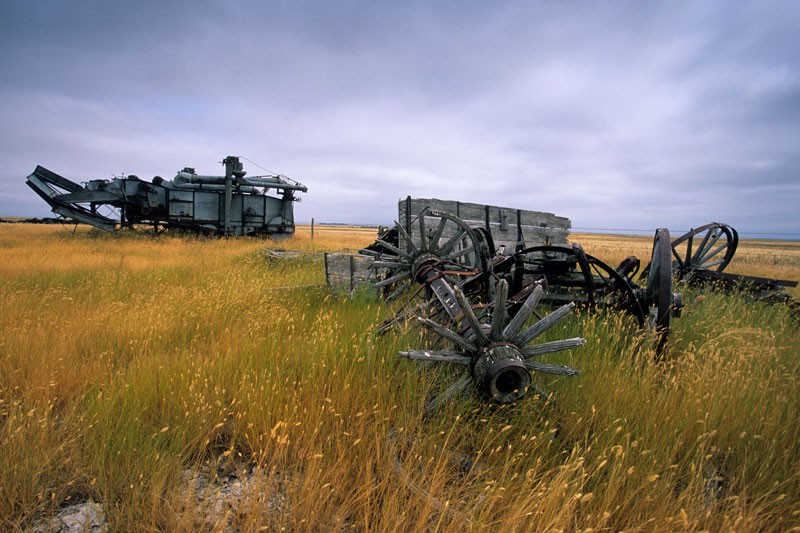
Out in the greasewood, I found a crossing over a long straight ditch, part of a water control project operated by the PFRA. In addition to community pastures, the agency developed reservoirs and irrigation projects, provided technical and financial assistance for smaller water projects such as livestock watering dams or dugouts on private land, and operated a tree nursery and shelterbelt program to help farmers establish windbreaks across erosion-prone fields and around farmyards. All these programs are being dismantled. Each one is important to prairie agriculture and rural communities, but the loss of the community pasture program also has global implications.
When I finished in the greasewood flat, it was growing dusk. The next morning, I followed a trail – just two wheel tracks in the grass – deep into upland prairie. Soon I was out of sight of any road or building; only the trails and the oil wells and the stakes for one more drilling site interrupted the sweep of grass and sky. This was the heart of the community pasture, one of the last large remnants of native prairie in this country. You might imagine it as empty, but that’s not how it feels: instead it feels huge, and present. Drifts of wildflowers claim patches of suitable soil; more subtle shadings of grasses and shrubs whisper the histories of slope and moisture, of snowdrifts and bison trails. Birds sing from stones or from unsteady perches atop the taller plant stalks. All this I noticed as I sketched the topography of the site and started into my quadrats. Still, it was some time before I gave my attention to another sound behind it all, a sound so steady and gentle that I might have missed it had it not been for one peculiar quality. How could that beautiful trill keep falling, falling, endlessly descending in pitch?
When I described the sound to my supervisor back in the city, he knew immediately what I was hearing: Sprague’s pipits, singing so high in the sky that I could not see them, and so many of them that each descending trill blended seamlessly into another. I grew up on a farm in native prairie, but I had never heard anything like that. The private pastures back home were too small, or not as healthy, even though my parents love their land so fiercely that they donated a conservation easement on it – the first one in the entire province.
Global responsibility
Prairie land is an endangered ecosystem. In Saskatchewan, less than 20 per cent of it remains, and much of that is in small fragments or degraded or both. The PFRA pasture lands are so crucial for the survival of grassland and its inhabitants that they are included in Saskatchewan’s Representative Areas Network, which in turn is part of our commitment to protect natural landscapes under international agreements. This is a global responsibility.
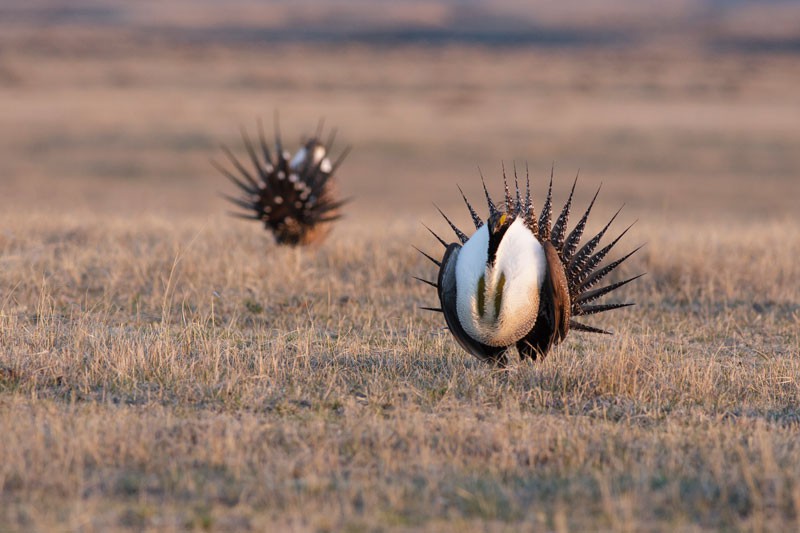
Yet the provincial government has proposed selling off the land, assuring concerned citizens that any natural grassland sold would be protected with “no-break, no-drain conservation easements.” This simplistic measure gives no recognition to the active management role of the PFRA. Prairie cannot thrive untouched, without the ancient forces of wildfires and freely moving bison herds to give cycles of cleansing and rest. Cattle grazing offers a substitute, but its application is both science and art.
One day I worked in a light rain. A pasture rider startled me, appearing suddenly over a nearby ridge. He wanted to know what I was doing, but mostly he wanted my yellow rainsuit put away. I was spooking the cattle. Cows are already nervous at the sight of a person on foot, but the bright suit was too much. I wished I had a long oilcloth coat like that rider. I’ve forgotten whether I got soaked or quit for the day, but I remember the man’s frustration about the broken fence where a cow had bolted, beyond my view. I wonder what plans were interrupted – perhaps treating sick animals, noting grass conditions to judge when to move a herd to a new paddock, riding over to check on the spread of an invasive plant, or stopping by an oil drilling site to make sure the vehicles were not leaving ruts in the rain-softened soil.
After that first assignment, I continued to work in oil fields, mostly in native prairie, telling myself I was helping to protect it, but slowly becoming more and more convinced: all I was doing was helping the oil companies get their projects approved. By the spring of 2012, watching new access roads stretching and branching through another PFRA pasture, I had seen enough. Surely with so little native prairie left, we could set aside these lands as Crown mineral reserves and not even dent our oil production.
Then came the federal announcement. Instead of halting the sprawl of roads and pipelines, the government was eliminating the agency that worked on the front line to minimize their damage. As the province moved to off-load the problem onto patrons, a small group of citizens turned to Trevor Herriot, whose lone voice as a grassland naturalist, author, and blogger had been calling out for action. Together this group organized a lecture and forum in late November 2012 in Regina. At the end of the day, a dozen of us signed onto a steering committee for further action in concert with other groups. The forum included presentations from the First Nations Sustainable Land Management Joint Venture on their proposal to take over the management of the pastures for both conservation purposes and economic opportunities, and from a farmer organizing a January meeting which was to establish the Community Pasture Patrons Association of Saskatchewan. This group immediately called on the government to delay the transfer of the first 10 pastures.
Public Pastures – Public Interest
Strangely absent from the November forum was any representation from the Prairie Conservation Action Plan. Strange, that is, until you consider that it is an umbrella organization of government agencies and NGOs. Again and again, the organizations most concerned with prairie conservation have backed away from any public statement, citing conflicts of interest or too many board members abstaining from votes. The trend began to shift in March when a second forum in Saskatoon drew over 100 participants and produced a rough list of principles for the transition of the pastures, emphasizing ongoing public ownership, livestock grazing, and professional management to protect the natural and cultural heritage of these lands. Subsequent work by Public Pastures – Public Interest produced a vision document that has since been endorsed by over 40 conservation groups across North America. Still, some key groups could not clear the way for their own membership’s support to be heard through the filters of their conflicted boards.
Public Pastures – Public Interest remains a loose-knit organization with diverse member initiatives in partnership with other networks. Working with the Saskatchewan Justice Institute and faculty members at the University of Regina, I helped organize a film screening and panel presentation about the pastures in early April. Speaking on the panel, a First Nations Elder startled me with his critical view of cattle grazing, saying the cows trample graves and introduce toxic substances to the grasslands from inoculants and feed additives, rendering traditional medicinal plants unusable. Another First Nations person in the audience objected to the film’s attention to the demise of the bison, neglecting to cover the devastation of the people for whom the prairie was home. Instead of a lonely hero speaking for the land, I was once again a humbled student.

A panellist drew attention to the “voiceless creatures” of the grasslands shown in the film. They are voiceless only when we drown them out. I meet them on my walks and am often astonished by their symbolic connection to whatever is troubling my mind. Ravens and moose have encouraged me to be bold and contrary. A grouse, the spiral dancer, suggested that I look not only outward but within. Only once this season have I heard house sparrows. That day I was to help host an Aboriginal storytelling event at our local library, and these non-native birds with their harsh voices reminded me: hush, listen; you are still one of the noisy newcomers.




